Python_Plotly_添加按钮,下拉菜单,滑动条
1. 添加滑动条:
#!/usr/bin/env python # -*- coding: utf-8 -*- # author:Zhang Kai time:2020/4/14 import plotly.graph_objects as go import numpy as np # Create figure fig = go.Figure() # Add traces, one for each slider step for step in np.arange(0, 5, 0.1): fig.add_trace( go.Scatter( visible=False, line=dict(color="#00CED1", width=6), name="𝜈 = " + str(step), x=np.arange(0, 10, 0.01), y=np.sin(step * np.arange(0, 10, 0.01)))) # Make 10th trace visible fig.data[10].visible = True # Create and add slider steps = [] for i in range(len(fig.data)): step = dict( method="restyle", args=["visible", [False] * len(fig.data)], ) step["args"][1][i] = True # Toggle i'th trace to "visible" steps.append(step) arg=["visible", [False] * len(fig.data)] print(step) print("--------------------") sliders = [dict( active=10, #默认值 currentvalue={"prefix": "Frequency:"}, #滑动条显示的名称; pad={"t": 10}, # 调节滑动条的位置,单位像素; steps=steps )] fig.update_layout( sliders=sliders )
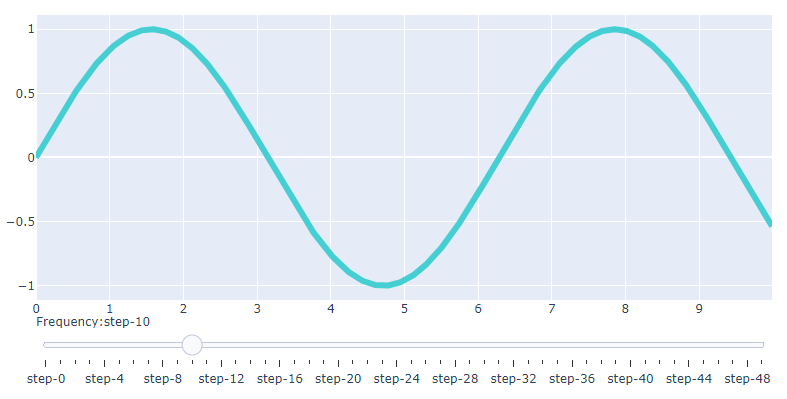
2. 按钮
import plotly.graph_objects as go import pandas as pd # load dataset df = pd.read_csv("https://raw.githubusercontent.com/plotly/datasets/master/volcano.csv") # create figure fig = go.Figure() # Add surface trace fig.add_trace(go.Surface(z=df.values.tolist(), colorscale="Viridis")) # Update plot sizing fig.update_layout( width=800, height=900, autosize=False, margin=dict(t=0, b=0, l=0, r=0), template="plotly_white", ) # Update 3D scene options fig.update_scenes( aspectratio=dict(x=1, y=1, z=0.7), aspectmode="manual" ) # Add dropdown fig.update_layout( updatemenus=[ dict( type = "buttons", direction = "left", buttons=list([ dict( args=["type", "surface"], label="3D Surface", method="restyle" ), dict( args=["type", "heatmap"], label="Heatmap", method="restyle" ) ]), pad={"r": 10, "t": 10}, showactive=True, x=0.11, xanchor="left", y=1.1, yanchor="top" ), ] ) # Add annotation fig.update_layout( annotations=[ dict(text="Trace type:", showarrow=False, x=0, y=1.08, yref="paper", align="left") ] ) fig.show()
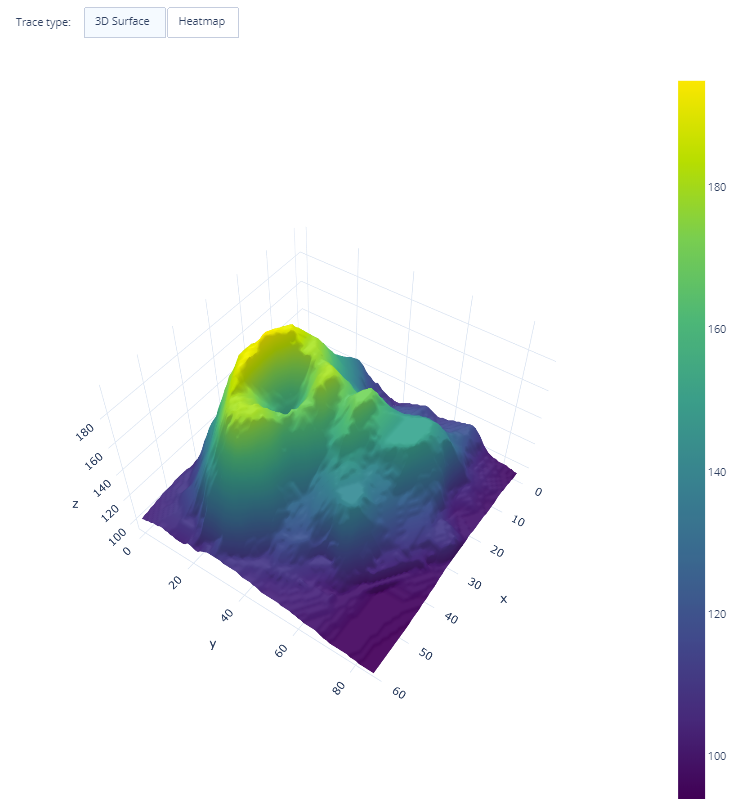
3. 下拉菜单
Mode: Restyle
a. 设置一个属性的下拉菜单:
import plotly.graph_objects as go import pandas as pd # load dataset df = pd.read_csv("https://raw.githubusercontent.com/plotly/datasets/master/volcano.csv") # create figure fig = go.Figure() # Add surface trace fig.add_trace(go.Surface(z=df.values.tolist(), colorscale="Viridis")) # Update plot sizing fig.update_layout( width=800, height=900, autosize=False, margin=dict(t=0, b=0, l=0, r=0), template="plotly_white", ) # Update 3D scene options fig.update_scenes( aspectratio=dict(x=1, y=1, z=0.7), aspectmode="manual" ) # Add dropdown fig.update_layout( updatemenus=[ dict( buttons=list([ dict( args=["type", "surface"], label="3D Surface", method="restyle" ), dict( args=["type", "heatmap"], label="Heatmap", method="restyle" ) ]), direction="down", pad={"r": 10, "t": 10}, showactive=True, x=0.1, xanchor="left", y=1.1, yanchor="top" ), ] ) # Add annotation fig.update_layout( annotations=[ dict(text="Trace type:", showarrow=False, x=0, y=1.085, yref="paper", align="left") ] ) fig.show()
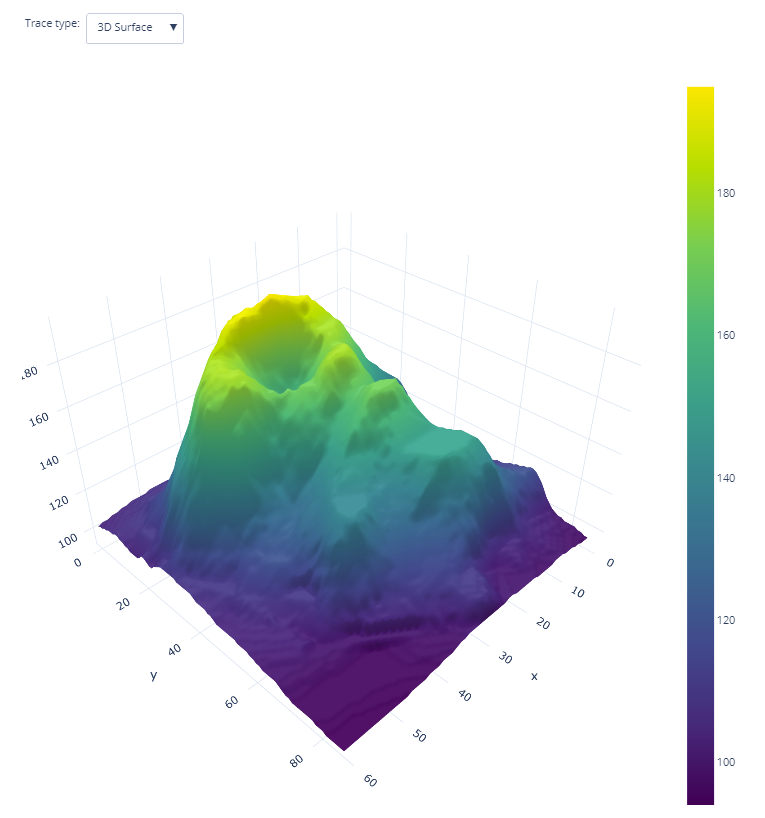
b. 设置多个属性的下拉菜单
import plotly.graph_objects as go import pandas as pd # load dataset df = pd.read_csv("https://raw.githubusercontent.com/plotly/datasets/master/volcano.csv") # Create figure fig = go.Figure() # Add surface trace fig.add_trace(go.Heatmap(z=df.values.tolist(), colorscale="Viridis")) # Update plot sizing fig.update_layout( width=800, height=900, autosize=False, margin=dict(t=100, b=0, l=0, r=0), ) # Update 3D scene options fig.update_scenes( aspectratio=dict(x=1, y=1, z=0.7), aspectmode="manual" ) # Add drowdowns button_layer_1_height = 1.08 fig.update_layout( updatemenus=[ dict( buttons=list([ dict( args=["colorscale", "Viridis"], label="Viridis", method="restyle" ), dict( args=["colorscale", "Cividis"], label="Cividis", method="restyle" ), dict( args=["colorscale", "Blues"], label="Blues", method="restyle" ), dict( args=["colorscale", "Greens"], label="Greens", method="restyle" ), ]), direction="down", pad={"r": 10, "t": 10}, showactive=True, x=0.1, xanchor="left", y=button_layer_1_height, yanchor="top" ), dict( buttons=list([ dict( args=["reversescale", False], label="False", method="restyle" ), dict( args=["reversescale", True], label="True", method="restyle" ) ]), direction="down", pad={"r": 10, "t": 10}, showactive=True, x=0.37, xanchor="left", y=button_layer_1_height, yanchor="top" ), dict( buttons=list([ dict( args=[{"contours.showlines": False, "type": "contour"}], label="Hide lines", method="restyle" ), dict( args=[{"contours.showlines": True, "type": "contour"}], label="Show lines", method="restyle" ), ]), direction="down", pad={"r": 10, "t": 10}, showactive=True, x=0.58, xanchor="left", y=button_layer_1_height, yanchor="top" ), ] ) fig.update_layout( annotations=[ dict(text="colorscale", x=0, xref="paper", y=1.06, yref="paper", align="left", showarrow=False), dict(text="Reverse<br>Colorscale", x=0.25, xref="paper", y=1.07, yref="paper", showarrow=False), dict(text="Lines", x=0.54, xref="paper", y=1.06, yref="paper", showarrow=False) ]) fig.show()
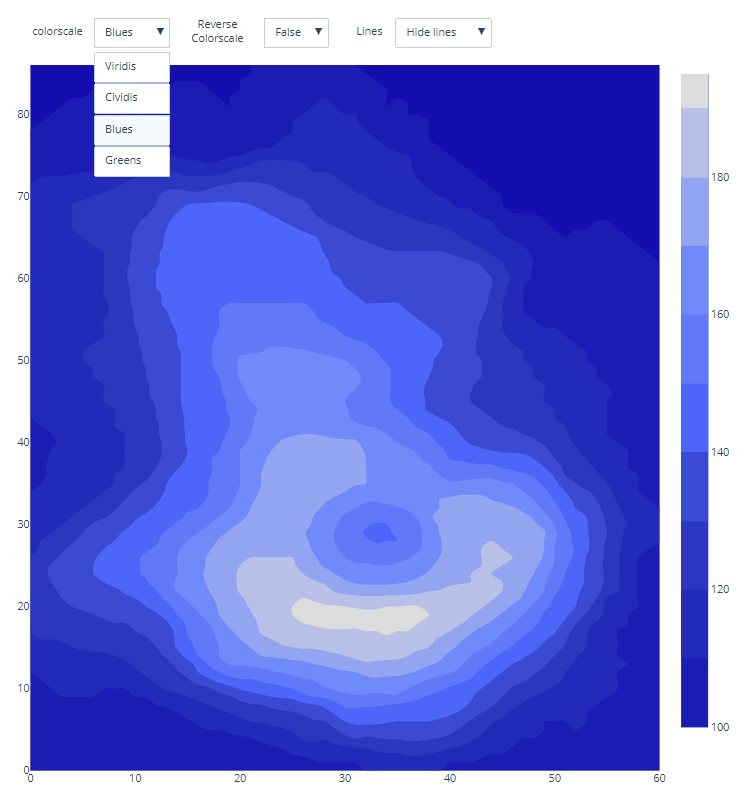
Mode: Relayout
import plotly.graph_objects as go # Generate dataset import numpy as np np.random.seed(1) x0 = np.random.normal(2, 0.4, 400) y0 = np.random.normal(2, 0.4, 400) x1 = np.random.normal(3, 0.6, 600) y1 = np.random.normal(6, 0.4, 400) x2 = np.random.normal(4, 0.2, 200) y2 = np.random.normal(4, 0.4, 200) # Create figure fig = go.Figure() # Add traces fig.add_trace( go.Scatter( x=x0, y=y0, mode="markers", marker=dict(color="DarkOrange") ) ) fig.add_trace( go.Scatter( x=x1, y=y1, mode="markers", marker=dict(color="Crimson") ) ) fig.add_trace( go.Scatter( x=x2, y=y2, mode="markers", marker=dict(color="RebeccaPurple") ) ) # Add buttons that add shapes cluster0 = [dict(type="circle", xref="x", yref="y", x0=min(x0), y0=min(y0), x1=max(x0), y1=max(y0), line=dict(color="DarkOrange"))] cluster1 = [dict(type="circle", xref="x", yref="y", x0=min(x1), y0=min(y1), x1=max(x1), y1=max(y1), line=dict(color="Crimson"))] cluster2 = [dict(type="circle", xref="x", yref="y", x0=min(x2), y0=min(y2), x1=max(x2), y1=max(y2), line=dict(color="RebeccaPurple"))] fig.update_layout( updatemenus=[ dict(buttons=list([ dict(label="None", method="relayout", args=["shapes", []]), dict(label="Cluster 0", method="relayout", args=["shapes", cluster0]), dict(label="Cluster 1", method="relayout", args=["shapes", cluster1]), dict(label="Cluster 2", method="relayout", args=["shapes", cluster2]), dict(label="All", method="relayout", args=["shapes", cluster0 + cluster1 + cluster2]) ]), ) ] ) # Update remaining layout properties fig.update_layout( title_text="Highlight Clusters", showlegend=False, ) fig.show()
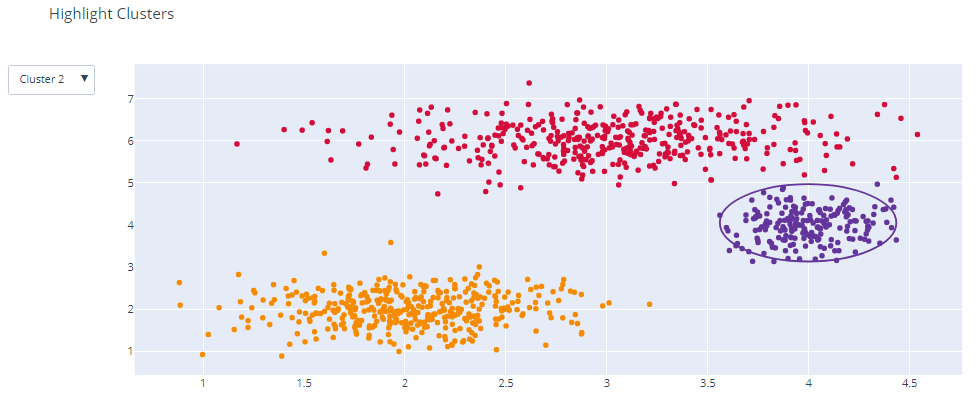
Mode: Update
import plotly.graph_objects as go import pandas as pd # Load dataset df = pd.read_csv( "https://raw.githubusercontent.com/plotly/datasets/master/finance-charts-apple.csv") df.columns = [col.replace("AAPL.", "") for col in df.columns] # Initialize figure fig = go.Figure() # Add Traces fig.add_trace( go.Scatter(x=list(df.index), y=list(df.High), name="High", line=dict(color="#33CFA5"))) fig.add_trace( go.Scatter(x=list(df.index), y=[df.High.mean()] * len(df.index), name="High Average", visible=False, line=dict(color="#33CFA5", dash="dash"))) fig.add_trace( go.Scatter(x=list(df.index), y=list(df.Low), name="Low", line=dict(color="#F06A6A"))) fig.add_trace( go.Scatter(x=list(df.index), y=[df.Low.mean()] * len(df.index), name="Low Average", visible=False, line=dict(color="#F06A6A", dash="dash"))) # Add Annotations and Buttons high_annotations = [dict(x="2016-03-01", y=df.High.mean(), xref="x", yref="y", text="High Average:<br> %.3f" % df.High.mean(), ax=0, ay=-40), dict(x=df.High.idxmax(), y=df.High.max(), xref="x", yref="y", text="High Max:<br> %.3f" % df.High.max(), ax=0, ay=-40)] low_annotations = [dict(x="2015-05-01", y=df.Low.mean(), xref="x", yref="y", text="Low Average:<br> %.3f" % df.Low.mean(), ax=0, ay=40), dict(x=df.High.idxmin(), y=df.Low.min(), xref="x", yref="y", text="Low Min:<br> %.3f" % df.Low.min(), ax=0, ay=40)] fig.update_layout( updatemenus=[ dict( active=0, buttons=list([ dict(label="None", method="update", args=[{"visible": [True, False, True, False]}, {"title": "Yahoo", "annotations": []}]), dict(label="High", method="update", args=[{"visible": [True, True, False, False]}, {"title": "Yahoo High", "annotations": high_annotations}]), dict(label="Low", method="update", args=[{"visible": [False, False, True, True]}, {"title": "Yahoo Low", "annotations": low_annotations}]), dict(label="Both", method="update", args=[{"visible": [True, True, True, True]}, {"title": "Yahoo", "annotations": high_annotations + low_annotations}]), ]), ) ]) # Set title fig.update_layout(title_text="Yahoo") fig.show()
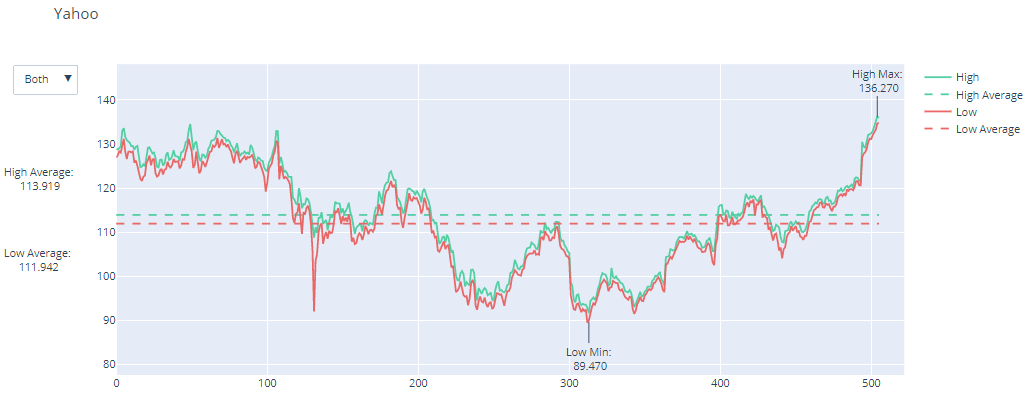
4. 区间滑动条
import plotly.graph_objects as go import pandas as pd # Load data df = pd.read_csv( "https://raw.githubusercontent.com/plotly/datasets/master/finance-charts-apple.csv") df.columns = [col.replace("AAPL.", "") for col in df.columns] # Create figure fig = go.Figure() fig.add_trace( go.Scatter(x=list(df.Date), y=list(df.High))) # Set title fig.update_layout( title_text="Time series with range slider and selectors" ) # Add range slider fig.update_layout( xaxis=dict( rangeselector=dict( buttons=list([ dict(count=1, label="1m", step="month", stepmode="backward"), dict(count=6, label="6m", step="month", stepmode="backward"), dict(count=1, label="YTD", step="year", stepmode="todate"), dict(count=1, label="1y", step="year", stepmode="backward"), dict(step="all") ]) ), rangeslider=dict( visible=True ), type="date" ) ) fig.show()
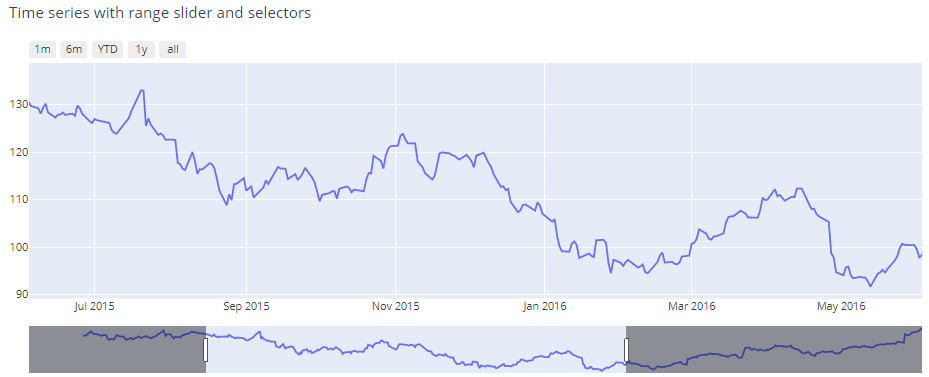

import plotly.graph_objects as go # Create figure fig = go.Figure() # Add traces fig.add_trace(go.Scatter( x=["2013-01-15", "2013-01-29", "2013-02-26", "2013-04-19", "2013-07-02", "2013-08-27", "2013-10-22", "2014-01-20", "2014-05-05", "2014-07-01", "2015-02-09", "2015-04-13", "2015-05-13", "2015-06-08", "2015-08-05", "2016-02-25"], y=["8", "3", "2", "10", "5", "5", "6", "8", "3", "3", "7", "5", "10", "10", "9", "14"], name="var0", text=["8", "3", "2", "10", "5", "5", "6", "8", "3", "3", "7", "5", "10", "10", "9", "14"], yaxis="y", )) fig.add_trace(go.Scatter( x=["2015-04-13", "2015-05-13", "2015-06-08", "2015-08-05", "2016-02-25"], y=["53.0", "69.0", "89.0", "41.0", "41.0"], name="var1", text=["53.0", "69.0", "89.0", "41.0", "41.0"], yaxis="y2", )) fig.add_trace(go.Scatter( x=["2013-01-29", "2013-02-26", "2013-04-19", "2013-07-02", "2013-08-27", "2013-10-22", "2014-01-20", "2014-04-09", "2014-05-05", "2014-07-01", "2014-09-30", "2015-02-09", "2015-04-13", "2015-06-08", "2016-02-25"], y=["9.6", "4.6", "2.7", "8.3", "18", "7.3", "3", "7.5", "1.0", "0.5", "2.8", "9.2", "13", "5.8", "6.9"], name="var2", text=["9.6", "4.6", "2.7", "8.3", "18", "7.3", "3", "7.5", "1.0", "0.5", "2.8", "9.2", "13", "5.8", "6.9"], yaxis="y3", )) fig.add_trace(go.Scatter( x=["2013-01-29", "2013-02-26", "2013-04-19", "2013-07-02", "2013-08-27", "2013-10-22", "2014-01-20", "2014-04-09", "2014-05-05", "2014-07-01", "2014-09-30", "2015-02-09", "2015-04-13", "2015-06-08", "2016-02-25"], y=["6.9", "7.5", "7.3", "7.3", "6.9", "7.1", "8", "7.8", "7.4", "7.9", "7.9", "7.6", "7.2", "7.2", "8.0"], name="var3", text=["6.9", "7.5", "7.3", "7.3", "6.9", "7.1", "8", "7.8", "7.4", "7.9", "7.9", "7.6", "7.2", "7.2", "8.0"], yaxis="y4", )) fig.add_trace(go.Scatter( x=["2013-02-26", "2013-07-02", "2013-09-26", "2013-10-22", "2013-12-04", "2014-01-02", "2014-01-20", "2014-05-05", "2014-07-01", "2015-02-09", "2015-05-05"], y=["290", "1078", "263", "407", "660", "740", "33", "374", "95", "734", "3000"], name="var4", text=["290", "1078", "263", "407", "660", "740", "33", "374", "95", "734", "3000"], yaxis="y5", )) # style all the traces fig.update_traces( hoverinfo="name+x+text", line={"width": 0.5}, marker={"size": 8}, mode="lines+markers", showlegend=False ) # Add annotations fig.update_layout( annotations=[ dict( x="2013-06-01", y=0, arrowcolor="rgba(63, 81, 181, 0.2)", arrowsize=0.3, ax=0, ay=30, text="state1", xref="x", yanchor="bottom", yref="y" ), dict( x="2014-09-13", y=0, arrowcolor="rgba(76, 175, 80, 0.1)", arrowsize=0.3, ax=0, ay=30, text="state2", xref="x", yanchor="bottom", yref="y" ) ], ) # Add shapes fig.update_layout( shapes=[ dict( fillcolor="rgba(63, 81, 181, 0.2)", line={"width": 0}, type="rect", x0="2013-01-15", x1="2013-10-17", xref="x", y0=0, y1=0.95, yref="paper" ), dict( fillcolor="rgba(76, 175, 80, 0.1)", line={"width": 0}, type="rect", x0="2013-10-22", x1="2015-08-05", xref="x", y0=0, y1=0.95, yref="paper" ) ] ) # Update axes fig.update_layout( xaxis=dict( autorange=True, range=["2012-10-31 18:36:37.3129", "2016-05-10 05:23:22.6871"], rangeslider=dict( autorange=True, range=["2012-10-31 18:36:37.3129", "2016-05-10 05:23:22.6871"] ), type="date" ), yaxis=dict( anchor="x", autorange=True, domain=[0, 0.2], linecolor="#673ab7", mirror=True, range=[-60.0858369099, 28.4406294707], showline=True, side="right", tickfont={"color": "#673ab7"}, tickmode="auto", ticks="", titlefont={"color": "#673ab7"}, type="linear", zeroline=False ), yaxis2=dict( anchor="x", autorange=True, domain=[0.2, 0.4], linecolor="#E91E63", mirror=True, range=[29.3787777032, 100.621222297], showline=True, side="right", tickfont={"color": "#E91E63"}, tickmode="auto", ticks="", titlefont={"color": "#E91E63"}, type="linear", zeroline=False ), yaxis3=dict( anchor="x", autorange=True, domain=[0.4, 0.6], linecolor="#795548", mirror=True, range=[-3.73690396239, 22.2369039624], showline=True, side="right", tickfont={"color": "#795548"}, tickmode="auto", ticks="", title="mg/L", titlefont={"color": "#795548"}, type="linear", zeroline=False ), yaxis4=dict( anchor="x", autorange=True, domain=[0.6, 0.8], linecolor="#607d8b", mirror=True, range=[6.63368032236, 8.26631967764], showline=True, side="right", tickfont={"color": "#607d8b"}, tickmode="auto", ticks="", title="mmol/L", titlefont={"color": "#607d8b"}, type="linear", zeroline=False ), yaxis5=dict( anchor="x", autorange=True, domain=[0.8, 1], linecolor="#2196F3", mirror=True, range=[-685.336803224, 3718.33680322], showline=True, side="right", tickfont={"color": "#2196F3"}, tickmode="auto", ticks="", title="mg/Kg", titlefont={"color": "#2196F3"}, type="linear", zeroline=False ) ) # Update layout fig.update_layout( dragmode="zoom", hovermode="x", legend=dict(traceorder="reversed"), height=600, template="plotly_white", margin=dict( t=100, b=100 ), ) fig.show()
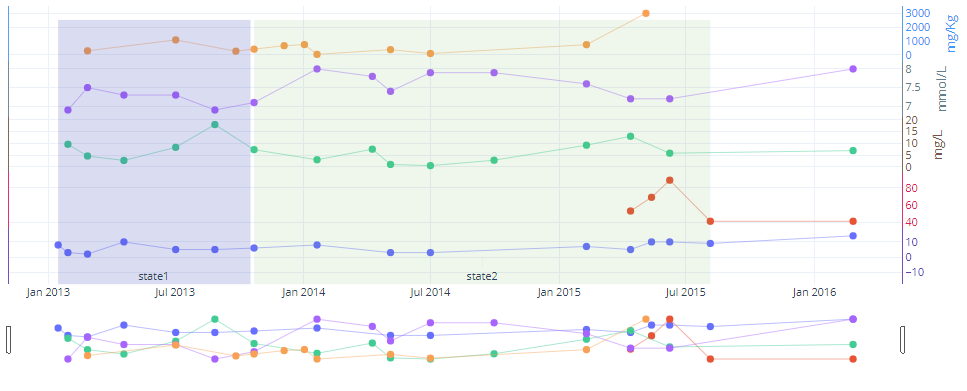




 浙公网安备 33010602011771号
浙公网安备 33010602011771号